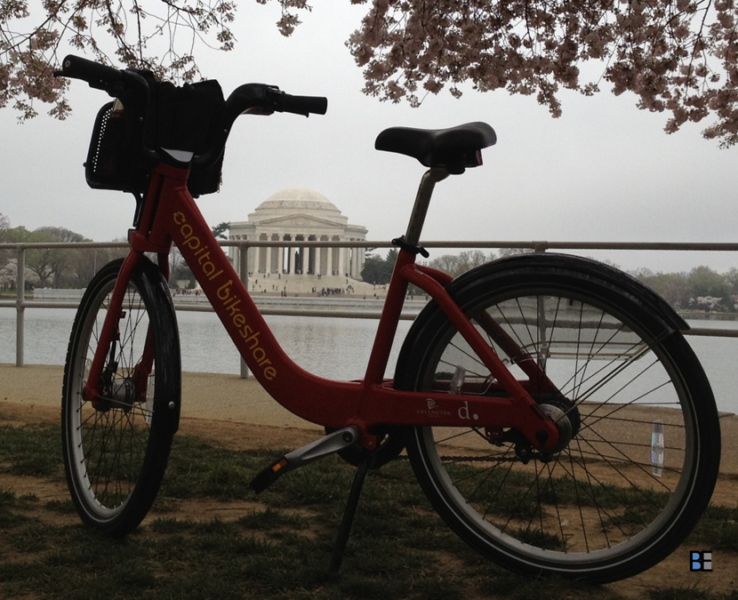As someone who studies the risks of human consequences for each level of warming our planet may endure, this guide – full of practical tips for low-carbon living – brings me hope.
It was a weekend morning and I decided to heed the exceedingly warm weather rumors of a burst of blossoms weeks before the traditional Washington DC cherry blossoms peak. I took advantage of my annual Capital Bikesharemembership and walked 3 blocks to pick up a bike to go see this most ephemeral signal of spring – delicate blossoms surrounding President Jefferson’s memorial.

I took advantage of my Capital Bikeshare membership to dash down to the earlier-than-expected burst of cherry blossoms near the Jefferson Memorial on March 18, 2012. Photo by B. Ekwurzel.
I have a Capital Bikeshare membership because I had made the decision to live closer to work and be within biking distance. In addition to being a low-carbon commute, I soon learned that it was “free” exercise every day and a nice transition between work and home.
On this unusually warm March day, I found it also was an easy way to get around the Washington Monument and the WWII memorial on my way to the tidal basin and the Jefferson Memorial. I passed people who were wary from walking so far away from their tour buses or parked cars. The links between those cars and the early appearance of cherry blossoms was uppermost in my mind.
Working on the Book Inspired Another 20 Percent Action
I knew the early spring this year was part of a longer trend of spring arriving on average about 10 days earlier in the northern hemisphere, in large part due to climate change. But this burst of cherry blossoms was very early. Instead of being discouraged on this weekend day, I was excited to be meeting on Monday morning with all the co-authors to discuss the release of our new book, Cooler-Smarter: Practical Steps to Low-Carbon Living.
You see, my role on the book was to convey the climate science and share the stories of how scientists as detectives had uncovered the myriad clues that stack up over decades to form overwhelming evidence that the climate was changing due to human activity. From the surge in carbon dioxide in our atmosphere, to the rising global average temperatures, to the curious scientists who look for clues in ice cores, to the discovery of climate change fingerprints in the atmosphere, to tracking plummeting summer Arctic sea ice, and recording the toll on stressed coral reefs. Yet, what I learned from the others on the author team improved my own lifestyle and reduced my carbon emission another twenty percent.
Digging Deeper for Reducing Personal Contribution to Carbon Overload
Because we live in a world that uses primarily fossil fuels—coal, oil, and gas to power our homes, vehicles, and even grow our food—we all contribute to global warming. We live in a country with the highest per capita carbon emissions to our atmosphere, trapping even more heat even compared to countries with a similar standard of living. The good news here is that this means we can all cut our emissions by at least 20 percent.

Each person, on average, in the U.S. emitted four times more carbon than the world average in 2006. Image source: Figure 1.1. from the book “Cooler, Smarter: Practical Steps to Low-Carbon Living” 2012.
By the time I started working on the book I had already reduced my personal emissions by changing from a long commute by car to work to a short commute that was within biking distance. The windows replaced on my home made a big difference in my heating and cooling bills and my emissions.
But after working on the book I realized that hanging onto a 20-year-old car and a 14-year-old car because they still worked was not going to cut it from a carbon standpoint. Trading in two 20 miles per gallon average vehicles for one used 40 miles per gallon vehicle meant over 15 years of that car’s lifetime I would save a lot of carbon from going into the atmosphere plus put an extra $18,000 dollars in my pocket for gas I did not have to buy to go the average annual distance of American drivers. Just that one decision meant I had made another reduction of around twenty percent in my personal carbon emissions.
This is why we wrote the book—to inform and motivate people to reduce their emissions—including people who had already made low-carbon choices. As a climate scientist, I know that to effectively tackle climate change we need efforts at every level of society, from individuals, communities, and businesses, to state, federal, and international.
What gives me hope is that if every American took this challenge this year and reduced their emissions by 20 percent—something both achievable and meaningful—it would be the same as taking away the emissions of one third of the coal fired power plants (around 200 of them) in the United States. The power of individual action can be amazing in crowds.

